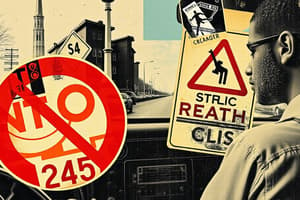Podcast
Questions and Answers
What do you need to use when identifying, analyzing, and minimizing risk? (Select all that apply)
What do you need to use when identifying, analyzing, and minimizing risk? (Select all that apply)
- Traffic laws (correct)
- Driver preparation (correct)
- Vehicle movements (correct)
Cover braking is _____
Cover braking is _____
Keeping your foot over the brake without actually braking.
When traffic gets heavier, dealing with risk is easier because the amount of space around your car gets smaller.
When traffic gets heavier, dealing with risk is easier because the amount of space around your car gets smaller.
False (B)
What is a common risk for drivers on country roads? (Select all that apply)
What is a common risk for drivers on country roads? (Select all that apply)
What's an example of risk while driving in the city?
What's an example of risk while driving in the city?
Risks involved with driving on the highway/freeway include _____. (Select all that apply)
Risks involved with driving on the highway/freeway include _____. (Select all that apply)
When driving at a fast pace, your target should be ______ ahead of you to compensate for the speed.
When driving at a fast pace, your target should be ______ ahead of you to compensate for the speed.
If another driver is tailgating you, it's safer to stay in your lane and let him or her go to the next.
If another driver is tailgating you, it's safer to stay in your lane and let him or her go to the next.
What risk won't you face on a crowded city street?
What risk won't you face on a crowded city street?
Flashcards are hidden until you start studying
Study Notes
Risk Management in Driving
- Identifying, analyzing, and minimizing risk requires knowledge of traffic laws, driver preparation, and understanding vehicle movements.
- Keeping your foot over the brake without actually braking is referred to as covering braking, a proactive safety measure.
Traffic Conditions and Risks
- Dealing with risk becomes more complicated in heavy traffic due to limited safe space around the vehicle.
- Common risks on country roads include poorly maintained roads, hard-to-see cross streets, and narrower lanes.
- In urban environments, risks include encountering delivery trucks that can obstruct traffic and create hazards.
Highway Driving Hazards
- Risks on highways include highway hypnosis, limited fields of vision, and the need for longer braking distances due to higher speeds.
- When driving quickly, it's crucial to maintain a target of 20-30 seconds ahead to effectively manage speed and navigate.
Handling Tailgating Situations
- If being tailgated, changing lanes to allow the tailgating vehicle to pass is safer than staying in the lane.
City Driving Challenges
- One risk not faced on a crowded city street is sudden curves in the road, which are more prevalent in rural or less populated areas.
Studying That Suits You
Use AI to generate personalized quizzes and flashcards to suit your learning preferences.




